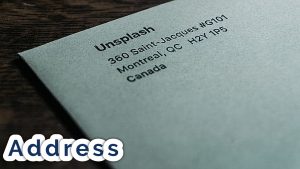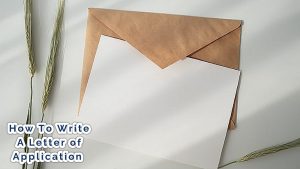How To Write An Application Letter: Letter writing is a written communication from one person to another. It is a communication in a permanent form. As a necessary part of 21st century existence, it has become necessary to present application letters in a permanent form because more relevance and originality is usually attached to information presented in permanent form, as they are also portable and retrievable for reference purposes.

Also see: Features or Characteristics of a formal letter
Brief History of Letter Writing
The practice of letter writing has been for thousands of years at even BC. Several books contained in the Bible were letters written from persons to persons, such as letters of Paul to Corinthians, Ephesians, etc. Ancient Egypt, Rome, Greece etc, also made use of letter writing.
According to Hellanicus, the very first letter to be written and sent was written and sent by the Persian Queen, Atossa at about 500BC. In the history, writing was more energy and time consuming as the writing tools were more natural and unadulterated.
Recommended: Causes, effects and solutions to brain drain in Nigeria
Types of Letter Writing
There are two basic types of letter writing: formal and informal. Some authors have extended the types to include semi-formal letter which has some elements of formal and informal letter. That is; it is not formal nor purely informal.
Informal Letter includes letters to close friends and relatives which is written to them in their informal/unofficial capacity. Here the language can be friendlier and pleasantries can be exchanged. The requirement of informal letter is less complex as opposed to formal letters.

Formal Letter are letters written to individuals, government and non-government organizations and corporate bodies etc in their official capacity.
Formal letters must be written with all caution and simplicity. Formal letters must adhere to a specific established format and must be written in a standard language structure.
Most application letters are formal letters, hence the essence of the distinction in this article. Therefore it is important to first determine the type of letter one intends to write in order to determine the format to be adopted.
Recommended: Advantages and Disadvantages of Judicial Precedence
How to Write an Application Letter
Application is a supplication for something, usually a favour or consideration. Supplication is a humble request. This suggests that an application letter must be humble.
In certain occasions, application letter may be needed for several purposes. One may be needing to write an application letter in occasions such as job employment, internship application, application for review, insurance claims, letter of complaint, etc. application letter may also be written for favours which are personal. Whichever way, it must comply with the format discussed below.
a. Sender or writer’s address: a formal letter must bear the address of the sender. The sender’s address is positioned at the top – right corner of the first lines of the paper.
Components of the sender’s address includes the address of the sender; it could be the home address, workplace address, regional operation address, residential address or any address traceable to the sender.

Below the address is the Local Government Area and State of the sender. Immediately after the Local Government Area and State comes the P.M.B (Postal Mail Box) if any, and lastly the date. This is the date on which the letter was written. Absence of date invalidates an application letter. The date is to be written in any of the formats: 7th July, 2021), (July 7, 2021).
The function of the sender’s address id focused on describing where the letter is emanating from. The writer may choose not to punctuate the address, but if she or he chooses to punctuate, it must be consistent.
An application letter written on a letter headed paper may have little or no need for the sender’s address because the customized letter head paper already has same.
b. Recipient Address: this is the address of the individual, body or organization receiving the letter. It is positioned underneath the sender’s address by the left side of the writing page.
Components of recipient address
Recipient address contains the portfolio/ office of the addressee/receiver. Example – The Managing Director, Obitex LTD. If the recipient is an individual, then his/her individual name will suffice and may come first before the portfolio (if any).
The next component is the address of the recipient. This is usually the workplace of the recipient, for instance – No. 8 Odede Avenue, Aba.
Recipient address is also known as inside address.
c. Salutation: This is a simple greeting to the recipient. It is positioned at rhe left side of the writing page, appearing a space beneath the recipient address. Salutation in the context of letter writing is simply the “dear sir/madam”.

Also see: How to write an affidavit excellently
d. Subject of the Letter: this is simply the title of the letter. It should be centered immediately below the “salutation”.
The subject of the letter must convey the purpose of the letter. It is more like an abstract. For example: “Application for Job Placement”
Format for Subject of the Letter
(a) The subject of the letter may be written by capitalizing each functional words. Example: “Application for Job Placement”. From this ample, one could see that each worlds were capitalized except “for” which is a preposition.
Note that when this format is used, the sentence must be underlined as such – “Application for Job Placement”
(b) The writer may choose to write the subject of the letter all in capital letter. If this format is used, the writer must not underline. For example: APPLICATION FOR JOB PLACEMENT.
e. Body of the Letter: body of the letter is the letter itself. It is the information contained in the letter relaying to the recipient the purpose of the letter.
Components of the Body of the Letter
Body of the letter includes the introduction, content of the letter and conclusion. Application letter being a formal letter, must be concise and precise. The writer must observe paragraphs where necessary. Use of pleasantries must be avoided as much as possible. The writer may have to start with a brief and direct introduction, followed by relaying the purpose of the letter, and then the conclusion.
Example: I am Okere Desmond, a graduate of Mass Communication. I humbly apply to be considered for an employment as a media secretary in your industry.
Attached to this letter is a copy of my curriculum vitae.
I will be glad to get a response from you.

f. Complimentary Close: this is simply the Yours’ Faithfully or Yours’ Sincerely. This is the very last part of a letter, appearing by the left end of the text.
g. Signature: beneath the complimentary close comes the sender’s signature. An application letter must be properly signed by the sender. Absence of signature renders the letter weightless.
h. Sender’s Name: the sender’s name comes directly after and under the signature. Email, phone number and other details of the sender should of course be incorporated in the curriculum vitae attached to the cover letter.
Recommended: How to become a successful lawyer
Application letter is a very sensitive exercise. Regardless of the evolution of technology, letter writing (especially informal letter) remains of utmost relevance and applicability.
An application letter must be concise and at the same time be precise. It must be written with respectable language and utmost politeness. In case of a job employment application, it is in fact the very first impression and personal encounter made by a prospective employee to an employer. It is advised that an application letter be proofread before it is submitted.

Edeh Samuel Chukwuemeka, ACMC, is a lawyer and a certified mediator/conciliator in Nigeria. He is also a developer with knowledge in various programming languages. Samuel is determined to leverage his skills in technology, SEO, and legal practice to revolutionize the legal profession worldwide by creating web and mobile applications that simplify legal research. Sam is also passionate about educating and providing valuable information to people.